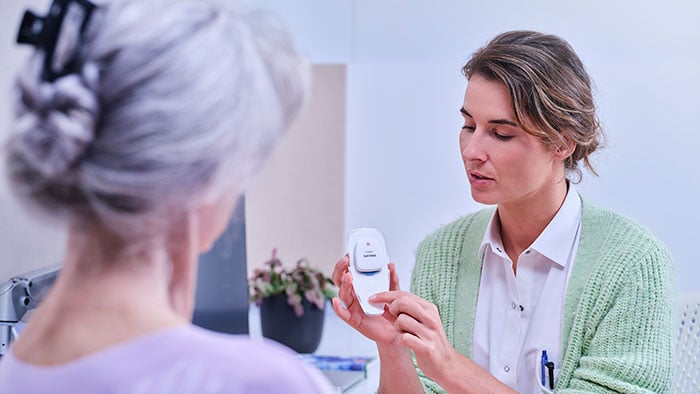Teaming up with policymakers to achieve health for all at the 77th World Health Assembly
Jul 11, 2024 | 5 minute read
The healthcare industry stands at a defining moment to pull out all the stops to tackle the imminent threat of climate change and the increase in non-communicable diseases [1]. With a historic resolution on climate change and health, the 77th World Health Assembly set the stage for driving critical and systemic change in healthcare.

On the heels of the event, where representatives met under the theme 'All for Health, Health for All', Philips is focused on how we can deliver better care to more people in a sustainable way. We believe that collaboration and partnerships are key to driving and delivering equitable and sustainable healthcare. At the highest level this means that strategic, economic and financial decisions are based – from the outset – on a shared recognition of the need for health equity and sustainable and regenerative use of resources.
In Geneva, representatives from 194 countries made meaningful progress on key issues in their deliberations for a new 2025-2028 global health strategy. At the Assembly and side meetings, the Philips delegation advocated for solutions to support sustainable and resilient healthcare through public and private collaboration, and shined a much-needed spotlight on improving patient access to treatment in areas such as stroke care and improving access to diagnostic imaging.

Historic climate change and health resolution passed
Passing a historic resolution on climate change and health, the Assembly called on countries to urgently prioritize health risks posed by climate change, which is an imminent threat to global health [2]. The resolution, championed by the Netherlands and Peru and supported by 35 countries, underscores the profound impacts of climate change on public health and sets out commitments to build climate-resilient and sustainable health systems.
The resolution on climate change is a significant milestone, as it will help accelerate critical and systemic change in healthcare, encouraging proactive steps to decarbonize the industry for safe societies and a healthy planet.
If healthcare were a country, it would be the world’s fifth-largest emitter of CO₂, accounting for over 4% of global emissions [3]. Climate change exacerbates health inequalities, from increasing food insecurity and air pollution to lack of access to clean water. Given the negative impact of climate change on public health, communities and society, the healthcare sector must become part of the solution and increase its efforts to mitigate its environmental impact – while adapting to climate change and changing healthcare services to anticipate the new climate-related burden.
“As a health technology leader, and by adopting innovative and sustainable care delivery models, technology and AI, we are enabling better health outcomes for more patients, reducing the cost of care and improving workflow efficiency, while simultaneously lowering the environmental impact,” said Jan-Willem Scheijgrond, Vice President and Global Head of Government and Public Affairs at Philips. “The resolution on climate change is a significant milestone, as it will help accelerate critical and systemic change in healthcare, encouraging proactive steps to decarbonize the industry for safe societies and a healthy planet.”

United action to transform stroke care
Another key focus for Philips was improving the standard of stroke care. This was the topic of significant panel discussions facilitated by Philips and the World Stroke Organization (WSO) as part of a multi-year partnership. Stroke is a leading cause of disability and death and is now at the forefront of conversations about tackling the increase in non-communicable diseases (NCDs) [4]. The event created space to discuss the global policy landscape on stroke, fueling awareness of the pressing need for a radical step forward in how stroke care is implemented worldwide.
An estimated 12 million people worldwide have a stroke each year [5]. However, there is minimal focus on healthcare expenditure and research funding to advance stroke care, compared to NCDs like cancer. Access to timely treatment remains limited, and huge disparities in stroke care persist. Yet, stroke is a highly curable disease, thanks to new technologies, procedures and clinical insights. Improving access to timely stroke care will play a critical role in achieving better outcomes [6].
The discussions highlighted breakthrough clinical study developments that demonstrate the benefits of minimally invasive thrombectomy treatment for a wider group of patients and explored the health and economic opportunities these advances could bring. Representatives from academic and global health institutions joined the panel discussions, including Dr Carla Goulart Peron, Chief Medical Officer at Philips. Dr Angelique Balguid, Philips’ Neurovascular Portfolio Lead, opened the event.
“Working together with the WSO, it was important for us to emphasize the importance of elevating stroke on the agenda at the WHO General Assembly, especially in the run-up to the UN High Level Meeting on NCDs in 2025,” said Goulart Peron. “Despite being proven to be highly impactful and cost-effective, access to new technology for acute stroke treatment remains limited, with huge disparities. I am hopeful the evidence-based recommendations put forward to the Ministries of Health can help ease the persistent inequalities in stroke care today.”
Commitments reinforce Diagnostics Resolution
Marking the first anniversary of the adoption of the landmark WHA Resolution on diagnostics, Scheijgrond also joined a side event for Diagnostics Day [7].
As president of COCIR, the European trade association representing the medical imaging, radiotherapy, health ICT and electromedical industries, Scheijgrond presented industry commitments supporting the implementation of the resolution, so that everyone who needs a diagnostic test can get one. Gaps in access are particularly strong when it comes to diagnostic imaging, which is why this resolution was adopted in 2023.
“In many countries, clinicians don’t have access to basic diagnostics imaging or laboratory tests needed to support patients,” said Scheijgrond. “The resolution on strengthening diagnostic capacity is focused on closing that gap. It is an important example of where public and private sector collaboration can drive more equitable and sustainable healthcare.”
Pandemic Preparedness Treaty still to come
On the final day of the Assembly, member countries agreed to a set of amendments to the International Health Regulations, aimed at bolstering the world's capacity to quickly identify and respond to pandemic threats.
Despite best efforts however, they could not reach an agreement on a Pandemic Preparedness Treaty that would improve global readiness for the next pandemic. An agreement is expected by next year [8].
To drive an industry reset and successfully deploy game-changing solutions at scale, fresh thinking, innovative approaches, and a willingness to team up and share learnings are required in every aspect of healthcare – procurement, supply chain, collaboration, regulation, etc. All while making sure that we do All for Health and Health for All.
Sources [1] World Health Organization. Seventy-seventh World Health Assembly – Daily update: 31 May 2024.
[2] World Health Organization. Climate change and health.
[3] Health Care Without Harm. Health care climate footprint report. September 2019.
[4] World Health Organization. On the road to 2025.
[5] GBD 2019 Stroke Collaborators. Global, regional, and national burden of stroke and its risk factors, 1990-2019: a systematic analysis for the Global Burden of Disease Study 2019. Lancet Neurol, October 2021.
[6] World Stroke Organization. New Trial Expands Window For Stroke Thrombectomy With Simpler Imaging. March 2024.
[7] World Health Organization. Strengthening diagnostics capacity. May 2023.
[8] Kerry, Vanessa. The Pandemic Treaty will succeed only with investment to build strong health systems. STAT, May 31, 2024.







